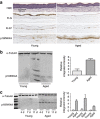p16INK4A influences the aging phenotype in the living skin equivalent
- PMID: 24335897
- PMCID: PMC3961602
- DOI: 10.1038/jid.2013.468
p16INK4A influences the aging phenotype in the living skin equivalent
Figures


References
-
- Aho S, Harding CR, Lee J, et al. Regulatory role for the profilaggrin N-terminal domain in epidermal homeostasis. J Invest Dermatol. 2012;132:2376–2385. - PubMed
-
- Campisi J, d'Adda di Fagagna F. Cellular senescence: When bad things happen to good cells. Nat Rev Mol Cell Biol. 2007;8:729–740. - PubMed
-
- Di Nunzio F, Maruggi G, Ferrari S, et al. Correction of laminin-5 deficiency in human epidermal stem cells by transcriptionally targeted lentiviral vectors. Mol Ther. 2008;16:1977–1985. - PubMed
Publication types
MeSH terms
Substances
LinkOut - more resources
Full Text Sources
Other Literature Sources
Medical

